Visited on June 13, 2012 (With members of the Lakeland Horticulture Society. Photo credits: Deborah McMillin)
Leaving Bantry Gardens, a short drive west took us to a small harbour near the seaside village of Glengarriff at the top of Bantry Bay. There the Gulf Stream’s warm currents created the opportunity for palm trees and subtropical plants to flourish on a nearby 37 acre island named Ilnacullin (Island of Holly), or as the locals call it Garinish Island.
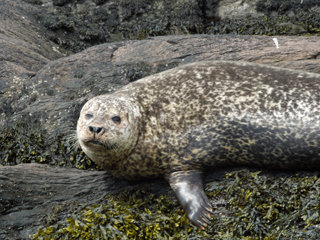
From the Garnish Ferry dock, two small passenger ferryboats carried our group for the one-mile trip to the island. We passed Seal Island where a colony of gray harbour seals perched on rocky outcrop. So used to the ferry traffic, they poise for the tourist cameras. From our vantage point in the bay we could see Glengarriff village in the shelter of the Caha mountain range.
In 1910 John Annan Bryce, who was a Belfast businessman and a Scottish Member of Parliament, and his wife Violet, purchased Ilnacullin Island from the British War Office. Ilnacullin Island was barren rock covered with gorse and heather. The intention was to create a magnificent garden and house on the island. Soil had to be moved to the island, rocks blasted and paths were laid. In partnership with Edwardian architect and garden designer Harold Peto, a walled garden, a tall clock tower, an Italianate garden and Grecian Temple were built.
A botanic display of trees, plants and flowers were created. Painters, poets and writers visited and worked with the view of the Kerry Mountains and the Irish bay waters surrounding them. After John Annan’s death in 1923, Violet continued to spend many years collecting and cultivating subtropical plants and trees to grow on the island. She planted and placed holly, Mediterranean shrubs and orchids to become part of the landscape of mountains and sea.
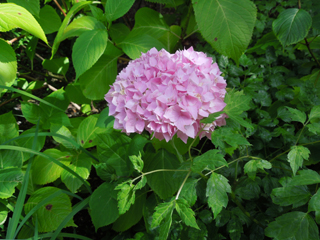
Murdo Mackenzie, a Scottish gardener, was put in charge of the garden in 1928. To overcome the inclement weather that was damaging the early plantings, he put in place a pine shelterbelt of Scots and Monterey to protect the exotic rare and tender plants in the garden from the fierce Atlantic winds. This allowed the collection of semi tropical plants to increase and thrive. Mackenzie collected leaves and other natural debris from the mainland to enrich his compost heap, as the existing soil on the island was thin and peaty. Ilnacullin Island has benefited from mild winters, high humidity and average annual rainfalls of 73 inches (or 1850 mm), which continues to contribute to the subtropical growth of the island’s ornamental plants.
Roland Bryce continued his parent’s work after their deaths and continued to develop the garden with Murdo Mackenzie. When Roland died in 1953, Ilnacullin Island was donated to the State. Mackenzie continued on as head gardener until he retired in 1971. At the time of our visit there were six full time gardeners and five summer horticulture students maintaining the island garden. No one lives on Ilnacullin Island now so the gardeners do leave to go to the mainland every evening.
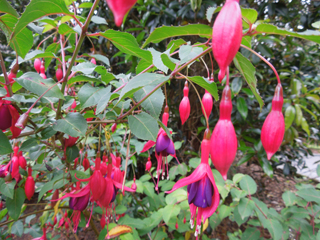
The path that I took from the jetty led me up steep stone steps to a woodland path. A Boronia heterophylla bush with red bell shaped flowers hanging in clumps and several clumps of fuchsia (Dodonaea viscose) with magenta and purple tear dropped flowers, far from their native soil of Australia, thrived in the rocky soil. A Chilean Crinodendron hookerianum shrub with deep red lantern shaped flowers brightened the shady downhill walkway to the Italian Garden.
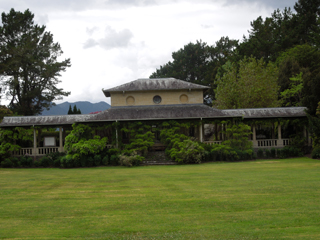
The Italian Garden with a casita built of bath stone, a lily pool and pavilion were constructed between the years 1910-1918, by John Annan Bryce. It was the centerpiece of the island. Harold Peto designed the garden based on the Italian style of architecture and garden design. Even though his style was formal, he did take into consideration the surrounding landscape and would blend the garden with its natural setting. Japanese and Islamic influence also played an important role in his approach to garden design. This was evident in the casita, reminiscent of the style of a Japanese teahouse. The steps to the casita and its supporting columns were covered with wisteria.
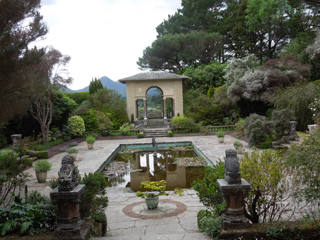
A formal sunken garden featuring a lily pool was the post card picture of the garden. The Italiante Garden folly’s mirror image was reflected in the water. A larix (larch) bonsai tree at the bottom of the stairs was reputed to be three hundred years old. The other potted bonsai specimens around the pool repeated the eastern Asia influence of design. Nearby were azaleas, fuchsias, camellias, myrtles, rhododendrons and large shrubs of pink flowering Manuka (Leptospermum scoparium) nicknamed the New Zealand Tea Tree.
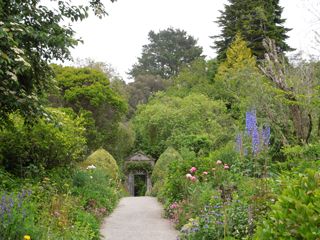
Leaving the formality of the sunken garden is the Victorian walled garden where weathered gray stoned walls with wrought iron 17th century Spanish gates, enclosed an exuberant display of herbaceous perennials in June bloom. On each side of the pathway were dianthus, phlox, knapweeds with blue florets (Centaurea Montana) and the giant knapweed with spiky yellow flower-heads (Centaurea macrocephala); erigeron, fringy white Meadow rue (Thalictrum aquilegifolium) mixed with the pale pink flower spikes of the Snake weed (Persicaria bistorta), to name a few.
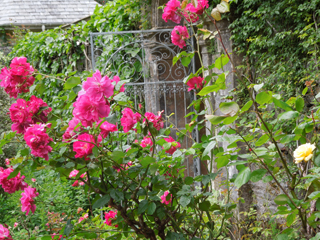
The blue bellflower clusters of the campanula were intertwined on the tall stakes holding erect towering blue delphiniums. The Paeony Rose grew so tall it was staked also. The weathered gray stoned walls supported espaliered fruit trees, roses and camellias. Shelter of the walls afforded protection to the fragrant Magnolia doltsopa, far from its native soil of the Eastern Himalayan region.
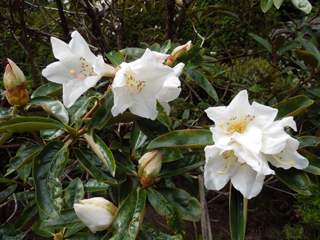
“Happy Valley,” which had been John Annan Bryce’s favorite spot, was a glade surrounded by Chilean Myrtle trees, tender rhododendron and acacia. The mix of South American and Oriental trees and shrubs were protected by Black Japanese pines (Pinus thunbergiana), which served as a windbreak.
Leaving the glade the path merged into woodlands where giant tree ferns grew. Steep stone steps led up to the highest point of the island. There a Martello Tower, which was built as a defense against the possibility of a Napoleonic invasion, stands. Wild alpine yellow daisies grew between jagged gray shale. The upward trek was worth the panoramic view of Bantry Bay and the Caha mountains beyond.
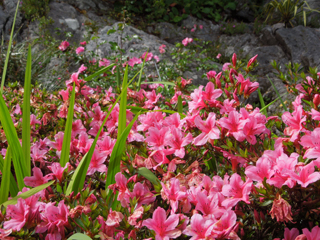
A downhill footpath led through a woodland maze with overhanging branches filtering the sunlight. A choice of direction moved me back into the sunlight where along side the pathway was the Centenary Garden, created in 2010 to celebrate to honor the acquisition of Ilnacullin by the Bryce family. Exposed rocks were partially covered with trailing pink roses and azaleas, the only splash of bright color against the green succulents and variegated yucca.
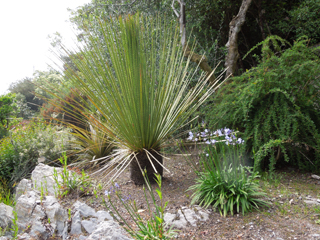
The collection featured tender plants from the warm temperate regions of the world. From Mexico were several Dasylirion miguihaunenis with long narrow lanced shaped spiny leaves. Agapanthus, with arching green leaves and soft blue tubular flowers, represented the flora of southern Africa. Beautiful clumps of Silver Spear (Astelia chatamica) with silver green spikes, originated from New Zealand. From the crevices of the rocks the purple Dorotheanthus ‘Ice Plant’ from South Africa, crept between the yuccas.
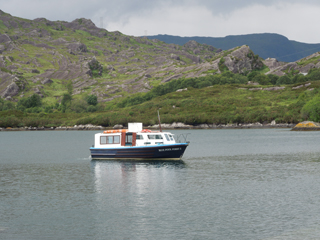
It was late afternoon by the time we met as a group at the jetty for the return trip by ferryboat to the mainland. We had been fortunate with a clear day to view the scenic coast of West Cork and visit the renowned gardens at Bantry House and Ilnacullin Island. The next morning the skies turned. The remainder of our south-west garden tour would be affected by rain.
Visit this garden at:www.garnishisland.com